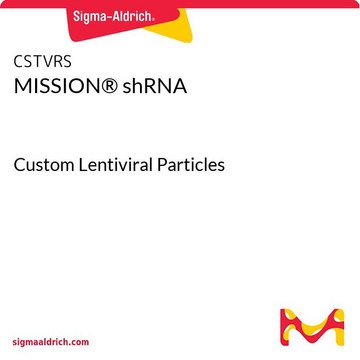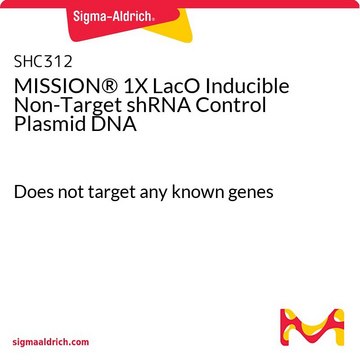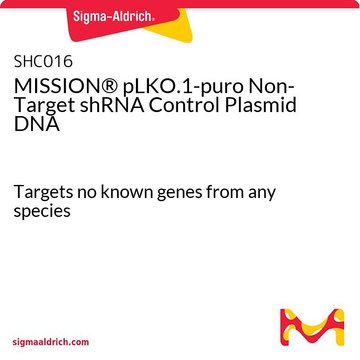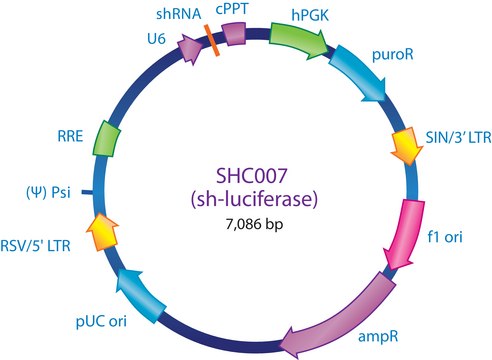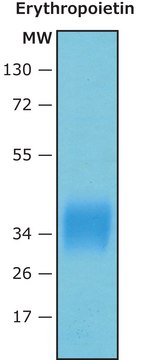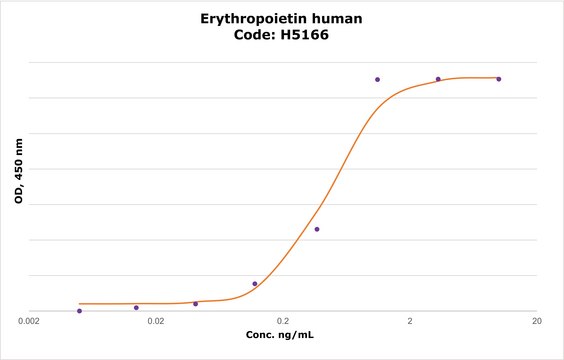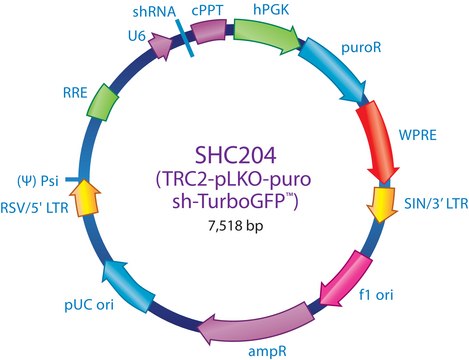推荐产品
产品线
MISSION®
运输
dry ice
储存温度
−20°C
一般描述
Sigma® is proud to offer IPTG-inducible vectors as the latest development from our continued partnership in TRC.
The pLKO vector has been redesigned to contain a LacI (repressor) and a modified human U6 shRNA promoter with LacO (operator) sequences. In the absence of IPTG (isopropyl-Β-D-thio-galactoside), an analogue of lactose, LacI binds to LacO preventing expression of the shRNA. When IPTG is present, the allosteric LacI repressor changes conformation, releasing itself from lacO modified human U6 promoter, and subsequently allows expression of the shRNA.
The MISSION 1X LacO Inducible TurboGFP™ shRNA Control is a 8,684 base pair lentivirus plasmid vector that contains an shRNA sequence targeting TurboGFP.[1] The TurboGFP shRNA Control Vector is useful as a positive knockdown control in experiments using the MISSION TurboGFP positive control vector or in cell lines expressing TurboGFP. TurboGFP is an improved variant of the green fluorescent protein copGFP cloned from copepoda Pontellina plumata.
Ampicillin and puromycin antibiotic resistance genes provide selection in bacterial or mammalian cells respectively. In addition, self-inactivating replication incompetent viral particles can be produced in packaging cells (HEK293T) by co-transfection with compatible packaging plasmids.[2][3]The TurboGFP shRNA Control Vector is provided as 10 μg of plasmid DNA in Tris-EDTA (TE) buffer at a concentration of 500 ng/μl.
The pLKO vector has been redesigned to contain a LacI (repressor) and a modified human U6 shRNA promoter with LacO (operator) sequences. In the absence of IPTG (isopropyl-Β-D-thio-galactoside), an analogue of lactose, LacI binds to LacO preventing expression of the shRNA. When IPTG is present, the allosteric LacI repressor changes conformation, releasing itself from lacO modified human U6 promoter, and subsequently allows expression of the shRNA.
The MISSION 1X LacO Inducible TurboGFP™ shRNA Control is a 8,684 base pair lentivirus plasmid vector that contains an shRNA sequence targeting TurboGFP.[1] The TurboGFP shRNA Control Vector is useful as a positive knockdown control in experiments using the MISSION TurboGFP positive control vector or in cell lines expressing TurboGFP. TurboGFP is an improved variant of the green fluorescent protein copGFP cloned from copepoda Pontellina plumata.
Ampicillin and puromycin antibiotic resistance genes provide selection in bacterial or mammalian cells respectively. In addition, self-inactivating replication incompetent viral particles can be produced in packaging cells (HEK293T) by co-transfection with compatible packaging plasmids.[2][3]The TurboGFP shRNA Control Vector is provided as 10 μg of plasmid DNA in Tris-EDTA (TE) buffer at a concentration of 500 ng/μl.
应用
To see more application data, protocols, vector maps visit sigma.com/shrna.
法律信息
使用本产品需遵守一个或多个许可协议。有关详细信息,请参阅http://sigmaaldrich.com/missionlicense。
MISSION is a registered trademark of Merck KGaA, Darmstadt, Germany
Sigma is a registered trademark of Sigma-Aldrich Co. LLC
TurboGFP is a trademark of Evrogen Co.
推荐
产品编号
说明
价格
储存分类代码
12 - Non Combustible Liquids
闪点(°F)
Not applicable
闪点(°C)
Not applicable
法规信息
新产品
R Zufferey et al.
Journal of virology, 72(12), 9873-9880 (1998-11-13)
In vivo transduction of nondividing cells by human immunodeficiency virus type 1 (HIV-1)-based vectors results in transgene expression that is stable over several months. However, the use of HIV-1 vectors raises concerns about their safety. Here we describe a self-inactivating
R Zufferey et al.
Nature biotechnology, 15(9), 871-875 (1997-11-05)
Retroviral vectors derived from lentiviruses such as HIV-1 are promising tools for human gene therapy because they mediate the in vivo delivery and long-term expression of transgenes in nondividing tissues. We describe an HIV vector system in which the virulence
Sheila A Stewart et al.
RNA (New York, N.Y.), 9(4), 493-501 (2003-03-22)
Genome-wide genetic approaches have proven useful for examining pathways of biological significance in model organisms such as Saccharomyces cerevisiae, Drosophila melanogastor, and Caenorhabditis elegans, but similar techniques have proven difficult to apply to mammalian systems. Although manipulation of the murine
我们的科学家团队拥有各种研究领域经验,包括生命科学、材料科学、化学合成、色谱、分析及许多其他领域.
联系技术服务部门
